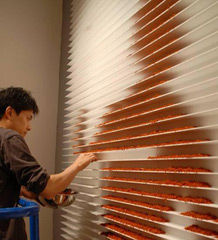Lee Changwon's understated and unfussy yet passionate way of speaking attests to the artist's earnest approach to his art. We asked Lee, currently showing, at the "MAM Project 017: Lee Changwon" exhibition, Parallel World, a work that juxtaposes graceful silhouettes created by mirror reflections with harsh realities glimpsed in newspaper and magazine stories, to tell us about his practice to date, and this particular work.

Lee Changwon
Born in South Korea in 1972, after majoring in sculpture at Seoul National University's College of Fine Art Lee studied at the Kunstakademie Münster, eventually spending over ten years in Germany before returning to Korea in 2011. Confronted with the alien food culture of a foreign land, Lee set about creating art from foodstuffs. Following various experiments including filling plastic silhouettes of himself and his wife with items like corn and tealeaves, removing the food from the plastic Lee placed it a little at a time onto an array of narrow panels affixed to the wall like Venetian blinds to create silhouettes, thus developing what could be described as his magnum opus. Lee has said that "the food in the plastic felt like it was shut in, and I wanted to liberate it from there," and once placed on shelves and exposed to the air around, the food appealed not only visually but also olfactorily, resulting in a work that stimulated the viewer's sense of touch too.


Lee Changwon at work
Focusing on the ephemerality and transient nature of his materials while working on the series for which he forms silhouettes out of the likes of tealeaves, coffee grounds, and safflower, Lee ventured to take bronzes - symbolizing permanence - as a motif. Appearing in A Day in Namsan are silhouettes of the bronze statues of Kim Gu and Ahn Jung-geun erected in Namsan Park as symbols of the Korean independence movement. In contrast to the robust materials conventionally used, such as bronze, Lee's work is made from coffee grounds. The fragility of coffee grounds - one puff and they're gone - suggests how mutable public opinion of heroes cast in bronze can be.

[left] Hurrah!
Ground coffee, wooden panels
200 x 500 cm
2009
[right] A Day in Namsan
Ground coffee, wooden panels
500 x 400 cm
2009
Installation view: Hangaram Art Museum, Seoul Arts Center.
Light is a vital element in the artworks of Lee Changwon, who has always been fascinated by stained glass. In the case of the aforementioned work, the silhouettes are formed by the material, eg coffee grounds, and the reflection of light between the slats. According to Lee, he was appealed by the way in which reflections of light "show the non-material aspect of the material, and at the same time create new material." Parallel World also makes skillful use of this reflecting light.

Parallel World
Digital prints, mirrors, lights, pedestals
2012
Installation view: "MAM Project 017: Lee Changwon," Mori Art Museum, 2012
Photo: Kioku Keizo
Stepping into the gallery we are surrounded by silhouettes in light calling to mind scenes such as the birth of Christ, Noah's ark, and Matisse's Dance. Dropping our gaze to the pedestals arranged along the wall to see where these dynamic silhouettes have come from, we find mirrors, affixed to which are images of newspaper and magazine stories on various incidents, horrific scenes from war-torn regions, and the Great East Japan Earthquake. Pieces have been cut out and light shone on the parts where the mirror is exposed, the resulting reflections forming silhouettes that are projected on the wall.

Parallel World
Digital prints, mirrors, lights, pedestals
2012
Installation view: "MAM Project 017: Lee Changwon," Mori Art Museum, 2012
Photo: Kioku Keizo
Lee speaks of the silhouettes thrown into relief as having "broken loose" from their original context. By juxtaposing silhouette and original news photo Lee creates a space in which silhouettes of light extracted from "reality" weave new stories. With this work Lee succeeds in embodying something "born out of reality, that transcends reality," and comments that he wants to "question the meaning of art, and the relationship between real society and art." Touching also on today's tendency to bombard us with images, but only reveal the surface of things, he says, "I wanted to show the relational aspect of how phenomena are so often concealed behind posed images."
Listening to Lee speak, I was especially struck by his use of the word "liberation." A series of works born out of a desire to liberate materials sealed in plastic at the experimental stage; Parallel World in which silhouettes dance, liberated from their original news photos - in other words, Lee is someone who knows that it is possible to be freed from the curse of any single way of seeing things, doing things, set of values. He has said that "the role of art is to give us the opportunity to look from a different perspective," and accordingly he delivers this to us via his artworks, guiding us toward the realization that there are many different ways of viewing the world.
Perhaps we listeners were also liberated in a sense, by Lee's polite way of speaking and the sincerity of his responses; those at the artist talk certainly had plenty of questions. Lee's works make us want to know more, and I hope as many people as possible will take the opportunity to experience this first showing of Lee Changwon's work on Japanese soil.
Text by Sakai Atsuko (Educator, Public Programs, Mori Art Museum)
■Relevant information
・MAM Project 017: Lee Changwon
16 June - 28 October, 2012








